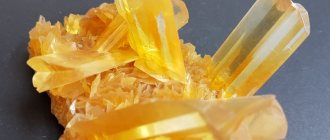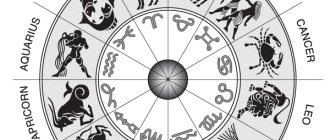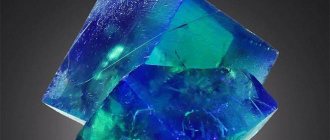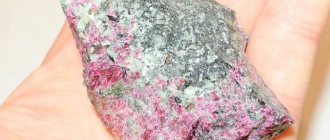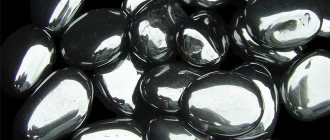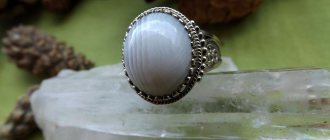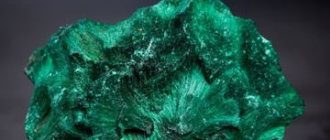This stone belongs to the spar family. It is used in a wide variety of sectors of human life. This includes the making of ceramics and jewelry, magic, and alternative medicine. We will talk about all this in our article. You will also learn how to use the mineral as a talisman, and who it will suit.
Varieties of albite
Based on its structure and physical properties, albite is classified into the following varieties:
- A high mineral with a disordered structure and resistance to temperatures above 800°C;
- Low mineral with an ordered structure and resistance to temperature barriers of 700°C;
- Peristerist is a translucent stone with adularization and iridescence present;
- Clevelandite is a type of lamellar albite;
- Pericline - elongated crystals of pure white shades.
- Belomorite is similar in structure to peristerist, but the color palette includes violet, gray and blue-blue shades.
The appearance of albite became the basis for its name, which is from the Latin “albus” meaning “white”. However, along with white shades, the mineral contains gray colors, which become most noticeable after polishing due to the optical effect.
Description and types of albite
Albite is a mineral of igneous origin, formed during the solidification of volcanic magma. In nature, it occurs as a granular rock in combination with other representatives of igneous origin. The characteristic color is white, less often - other shades.
Representative of silicate feldspars. Translated from Latin - white. Synonyms: white scorl, white feldspar, albiclase, amazonite-plagioclase.
Scientists divide albite into several types based on structural features:
- High albite. The mineral can withstand temperatures up to 800 degrees and has a disordered, chaotic crystalline structure.
- Low albite. Similar to the previous one, but has an ordered crystalline structure and can withstand lower temperatures (up to 700 degrees).
- Peristerite. A translucent mineral of bluish-blue shades with iridescence (rainbow tints).
- Belomorit. Similar to the previous look, but the color palette is wider: gray, blue, and purple tones are possible.
- Clevelandite. It has a lamellar structure, reminiscent of a layer cake.
- Periclin. The stone is white in color, the peculiarity of which is long-needled light crystals.
Watch a video review about some types of stone:
Mineral deposits
Despite the fact that albite deposits are located throughout the planet, finding mineral deposits in their pure form is not so easy. Basically, it is mined together with other rocks and minerals, and deposits are classified depending on the purpose of its further use.
Transparent crystals, from which beautiful jewelry is made, are mined on the African continent - in Kenya, Zimbabwe and Madagascar. Large mines of albite, which is used industrially, are located in the United States (Pennsylvania, Georgia and Virginia) and in the vicinity of Ottawa.
Many mineral deposits are located in Russia. Transparent stones are mined in the Irkutsk region, the Middle Urals and the Kola Peninsula. The surroundings of the Malkhansky ridge of Southern Transbaikalia are famous for the mining of collection samples of clevelandite - lamellar albite, which is also found in California, USA.
Large crystals are mined in Binntal in Switzerland and Minas Geras in Brazil. Stones mined in the Eastern Pamirs of Tajikistan and the northern part of Norway have an iridescent effect. Back to contents
Description
Albit (from Latin albus - white, in color, English albite) is a white silicate feldspar. The shade of this fossil may vary depending on where it is mined. It is known that this spar can be different; it is found in bluish, grayish, violet, gold, brown, yellow, and orange colors. Depending on the chemical additives, the color of albite is saturated or pale.
The crystals that make up this mineral are characterized by an opaque structure with a glassy shimmer. This is a very interesting and multifaceted mineral. It is recommended to place albite amulets and talismans above the door; this serves as a certain protection against the influence of dark forces on the house. Products made from albite help give the owner peace of mind. Several types of mineral are known.
Types and subspecies of the breed
There are the following types:
- High albite is a representative with a chaotic structure that does not melt even at very high temperatures;
- Low albite has an ordered internal structure and withstands high temperatures;
- Cleavelandite - lamellar albite, mainly distributed in pegmatites, received its name thanks to the scientific research of Professor P. Cleaveland;
- Pericline is a type of stone with long light crystals, its deposits are often alpine-type veins;
- Peristerite is a partially translucent albite, characterized by iridescence or, not rarely, adularization.
Magical properties of albite
Pyramid made of albite mineral
Practicing magicians and esotericists call albite a conductor of two energies: the Moon and the Sun. The lunar mineral symbolizes Yin energy, the solar one – Yang. For harmony in a person, the balance of these two energies must be constantly maintained. That is why experts recommend wearing albite in pairs, charging each of the stones with its own energy. To do this, one crystal is laid out in the light of the full moon and hidden in a dark place during the day. The second stone, on the contrary, should be placed in the sun during the day and carefully hidden from moonlight at night.
The mineral has a beneficial effect on the human psyche, relieving stress, excitability and nervousness. It is simply necessary for emotional and impressionable individuals who react painfully to external stimuli. The stone will give them patience, calmness and poise.
The magical properties of a talisman with two stones will help normalize your emotional state and gain confidence in your own abilities. Albit will also act as a powerful talisman for the home. If you hang it above the front door, then negativity and dark forces will bypass the home.
The energy of albite can be increased by placing it together with a ruby, agate or emerald in a pyramid for 15 minutes.
Albit is an effective talisman for travelers. The gem will help them overcome difficulties on the road, as well as resolve issues with overnight stays and crossing borders. The mineral of the water element will also become a strong amulet for people whose life and activities are connected with the sea.
Artificial albite
Currently, there is no need to produce albite artificially. There are a lot of deposits of this spar.
Differences between a real stone and a fake
Due to its physical and chemical properties, this spar is difficult to melt and retains its appearance when exposed to acid, with the exception of hydrofluoric acid. Therefore, to determine the authenticity of a mineral, place it in a container with acid and watch the reaction; if nothing happens, the mineral is real.
Medicinal properties
In folk medicine, albite is used to prevent and alleviate chronic diseases of the abdominal organs: kidneys, liver, stomach, spleen and pancreas. The stone is considered an effective autoimmune remedy, suppresses depression and stress, promotes clarity of thought, reducing mental stress.
To experience the healing properties of a mineral, you do not have to carry it with you all the time. Albit treats with tactile contact, for which you need to take a horizontal position, apply it to the problem area and relax. The crystal will absorb discomfort and pain and significantly alleviate the patient’s condition.
After each procedure, the stone must be “freed” from the negative, for which it is held for 5 minutes under running water.
Back to contents
Zodiac sign
This is a universal mineral that is favorable for all zodiac signs. This stone emits only positive energy and cannot be dangerous. It is believed that albite bestows peace and tranquility. It has a special influence on water signs, Pisces, Scorpio, Cancer. An amulet with this mineral can be worn by Leos. Astrologers believe that you need to have two amulets made of this stone with you. A person must maintain a balance of lunar and solar flows, Yin energy and Yang energy. Each of the amulets should be charged, one with the energy of the moon, the second with the energy of the sun.
Medicinal properties
In medicine, this feldspar is used to eliminate problems in the gastrointestinal tract (liver, kidneys, spleen, pancreas, stomach). The stone is applied to the affected areas and left for a short time. Such manipulations should be carried out in a quiet, comfortable place; the patient must be in a horizontal position and relaxed. Only in this case will the healing properties of the stone appear. After use, the mineral should be placed in cool spring water for 20 minutes. This must be done so that the stone can get rid of the negative currents that it absorbed upon contact with the patient.
Areas of application of albite
The mineral is of genuine interest to scientists due to its twinning properties and crystalline form. It is actively used in gemological studies of the process of metamorphism, as it is directly involved in the formation of rocks.
In its pure form, albite, due to its hardness, as well as resistance to abrasion and heat, has found wide use in the abrasive, glass, ceramic and refractory industries. Ceramic dishes containing albite are widely popular due to their durability.
In construction, it is used as a finishing material and crushed stone, which is added to concrete solutions for their reliable setting.
In jewelry, albite is classified as “moon stones” and is not used very often. Beautiful jewelry is made from pure cut stones - beads, bracelets, earrings and pendants. Transparent cabochon-cut crystals, as well as naturally shaped specimens combining a mixture of several minerals, attract the attention of collectors.
Where is albite mined?
An industrial-scale mineral deposit was first discovered on the Scandinavian Peninsula, in Sweden.
Over 200 years, the geography of albite deposits has expanded, covering almost the entire planet:
- Africa – Madagascar, Zimbabwe, Kenya;
- America – USA, Brazil;
- Asia - Tajikistan;
- Europe - Russia (Ural, Transbaikalia), Greece, Norway, Switzerland.
Despite the wide distribution of the mineral, finding pure material is problematic: albite is almost always associated with other rocks.
Pure large specimens are supplied by Switzerland and the Brazilian “jewelry” state of Minas Gerais.
The heritage of Tajikistan and Norway are stones with iridescence.
Albit prices
Products made from this mineral are affordable. At stone fairs and in specialized stores, their cost varies within the following range:
- Ring in a silver frame – $25-30.
- Cabochon pendant – $7-10.
- Necklace – $25-40.
- Earrings in a cupronickel frame – $10-12.
- Souvenir ball – $70-80.
- Polished egg up to 6 cm high – $60-65.
- Albite crystal intergrown with tourmaline – $45-155 depending on the size of the sample.
Description of albite
White spar consists of many inclusions and chemical elements. The classic formula of albite is NaAlSi3O8. In addition to sodium, aluminum, silicon and oxygen, the mineral may contain chromium, lead, potassium, magnesium, and calcium. By themselves, they do not affect the shade, but pure albite is more valuable. The material withstands heating, melting, and aggressive chemical environments quite well. Of the acids, he is only afraid of hydrofluoric acid, and alkalis are not scary to him at all.
Albite crystals grow over many years. As a rule, they are shaped like plates or tablets.
If you cut the mineral, the sharp, uneven edges of the crystals will look like seashells.
Large clean stones are extremely rare in nature. Typically processed white spar weighs no more than ten grams, although there are exceptions. For example, huge nuggets up to twenty centimeters high were discovered in Ukraine.
White feldspar is quite fragile and breaks and breaks easily. Density on the Mohs scale is from 6.0 to 6.5. The crystals are usually white, less often colorless, transparent. Occasionally you come across specimens with red, yellow and brown tints. When heated, a restructuring of the crystalline structure occurs with the transformation of the mineral into andesite or high albite.
Difference from fake
Albite
Albite is often counterfeited, offering glass, plastic or the most common feldspar instead of the natural mineral. You can distinguish a fake stone from a real one by several signs:
- Heat resistance and refractoriness - natural albite does not melt under the influence of the fire of a candle or match, which cannot be said about a fake stone.
- Acid resistance – albite does not react to hydrochloric or sulfuric acid. The exception is hydrofluoric acid.
- Low thermal conductivity - real albite conducts heat poorly; it will heat up in the palm for a long time, unlike synthetic analogues.
It is rare to find counterfeits of regular albite on the stone market. Basically, ungodly craftsmen are interested in unique transparent, colored and plate crystals, which they try to cleverly copy and sell at the price of a real gem.
Checking Albit for authenticity
Although albite is not often attempted to be counterfeited, checking for authenticity will never be superfluous.
Regular white spar is counterfeited quite rarely, since it is neither a precious nor even a semi-precious stone. But the price of albite increases significantly when it comes to unique specimens. Transparent, lamellar or multi-colored stones may well be imitated using glass, plastic or a simple crystal.
To distinguish a genuine mineral from a fake, you need to remember the basic properties of albite - the stone does not dissolve in acids except hydrofluoric acid. You can drop a little sulfuric or hydrochloric acid solution onto the crystal that is being tested. The genuine crystal will not be damaged or change color.
You can also heat the white spar over low heat (a regular lighter will work fine). This mineral tolerates high temperatures well, so a small flame will not harm it.
Stone care
Albit is easy to care for and therefore does not require any special recommendations. It is enough to store the mineral in a soft case or box and protect it from falls and shocks due to its high fragility. If the stone does break or split, it is not recommended to wear it. The fragments should be collected very carefully, as they are very sharp due to their needle-like shape.
In case of contamination, albite is washed in cool water with the addition of baby soap, then rinsed and wiped with a soft piece of cloth. When actively using a stone for healing or magical purposes, it is temporarily placed in a saline solution. This will neutralize the negative energy that albite has absorbed.
History of the stone
Albite stone cannot boast of a long history. It was discovered in 1815 by Swedish geologists Berzelius and Hahn. Impressed by the unique shade of the gem and its interesting structure, they entered the new mineral into the catalog and gave it its modern name. It comes from the Latin albus - white.
However, scientists have not shown much interest in albite. They, like jewelers, were more interested in other varieties of spar, for example, precious moonstone. Only in the twentieth century was the mineral studied by the Russian scientist Fersman. On the shores of the White Sea, Fersman discovered unique varieties of spar with white-blue or white-violet colors. He called them belomorites, and blue and blue stones - peristerites. Belomorite and albite are not the same thing, as some believe: the stone from the White Sea is only a variety of this mineral.
Nowadays, albite is also known under the following names:
- white feldspar;
- white sherl;
- albiclase;
- Amazonite-plakioglas.
It is widely used in industry. White spar is also popular among finishers, jewelers, and tableware designers.
Horoscope
Albit can be used as an astrological talisman by absolutely all representatives of the zodiac system, except for signs of the element of Fire. Leos, Aries and Sagittarius are categorically not recommended to use the energy of the stone, as it has a destructive effect on the character and fate of its owner. Otherwise, this is a “positive” stone that will not harm anyone, but will only bestow peace and harmony.
He especially favors the signs of the Water element (Pisces, Scorpios and Cancers). The mineral will help them establish connections with other representatives of the Zodiac, balance the manifestation of negative and positive character traits, and bring good luck. Other signs can wear albite and use its properties, but their manifestation will not be as pronounced. Back to contents
5 / 5 ( 1 voice )
Related materials:
A little bit of magic
The crystal, in addition to healing properties, is also endowed with magical properties.
Since ancient times, astrologers, magicians and wizards have used it for various purposes. For example, astrologers claim that this mineral is an excellent conductor of energy between the Sun and the Moon. In this regard, magical rituals require the presence of at least 2 copies. Practicing magicians use plagioclase to relieve a person of stress, nervousness, and tension. An amulet with albite is recommended to be worn by people who are particularly emotional and susceptible to external irritants. However, in a single copy its impact will be very weak. That is why it is desirable that the amulet consist of a pair of stones. A pair of them will contribute to the acquisition of wisdom and clarity of mind by those who own them. Such talismans have significant power. It is recommended for those who like to travel to have this mineral with them. With its help, a wandering person will be able to avoid various dangers.
Chinese tradition uses the described mineral to create harmony in the inner world of a person and his environment. It is believed that to achieve such harmony, a person needs to possess the energies of Yin and Yang in the same ratio. If there is an excess of one of the forces, it is necessary to normalize it by adding the force that is missing. Thanks to lunar albite, you can attract Yin energy, and with the help of solar albite, you can attract Yang energy.
To give the stones the appropriate strength, one of them should be charged with the light of the Moon, and the other with the light of the Sun. It is important that lunar plagioclase is laid out on the windowsill during the new moon. In addition, you need to ensure that moonlight falls on the crystal. To preserve its magical properties, it is recommended to put the pebble in a dark place during the day, for example, in a box. Similar actions are performed with solar albite only during daylight hours.
The crystal, in addition to healing, is also endowed with magical properties.
This mineral is endowed with other magical qualities. Thus, thanks to him, a person learns a philosophical attitude towards everything that happens in his life. It benefits not only the person, but also his home. For example, there is an opinion that if you place a crystal on the front door of your home, it will be cleared of external negativity. In this case, the magic stone should be located on the outside of the door.
Plagioclase belongs to the water element, its miraculous properties are associated with the lunar cycles of ebb and flow. This circumstance made the mineral a symbol of the infinity of life. Interestingly, there is no specific zodiac sign that it suits. It can be worn as an amulet by water, fire, air, and earth signs. However, some astrologers still recommend plagioclase to the signs of Water (Scorpio, Cancer, Pisces) and Leo.
Thus, albite is a mineral that can be used for medicinal and magical purposes. Its advantage is its low price compared to precious and even semi-precious stones.
Properties
- Syngony:
Triclinic - Composition (formula):
Na[AlSi3O8] - Color:
White, gray - Trait Color:
White - Transparency:
Transparent - Cleavage:
Perfect - Fracture:
Uneven - Hardness:
6-6,5 - Density (specific gravity), g/cm3:
2,6
Where is the mineral used?
Albite is one of the “youngest” minerals for humans. However, the physicochemical properties of albite and its color range ensured its demand and use in various fields:
- These are test samples for studying metamorphic processes. This was influenced by the origin of albite and the participation of the mineral in their formation.
- The albite mineral is a good component that gives traditional finishing materials a new “sound.” Plus refractories and abrasives, an additive to concrete for strength. The industry is in demand for durable American and Russian stones.
- The mineral is quite hard, resistant to heat and abrasion. Therefore, kitchen ceramics containing albite are famous for their reliability and durability.
- Jewelers classify albite as a “moon” stone. Favorites include transparent or translucent minerals from the Black Continent and specimens with iridescence (that is, iridescent iridescence). The ideal cut for albite is a flat cabochon.
Collectors look for druses of unusual shapes or combinations of stones. Clevelandite is especially desirable as a collection stone. It is found in Transbaikalia, the Swiss Alps, Norway, and the Pamirs (Tajikistan).



